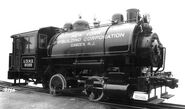
History
The Vulcan Iron Works, of Wilkes-Barre, Pennsylvania, was hired to build this oil burning 0-4-0 tank engine for New York Shipbuilding Corporation, in Camden, New Jersey. When completed in 1941, the locomotive, with builders plate #4309 was delivered to the New York Shipbuilding yard with Navy designation U.S.N.X. 2025 as seen in its builders' photographs.
In 1948, the engine was sold to the Carbon Limestone Company and renumbered to 17 , where it probably served in and around the quarry. Evidence of this is sometimes all too evident to her present crew, as boiler washes often reveal pieces of old scale, a sign of the mineral rich water used in her past. This was a blessing in disguise, as scale is detrimental to efficient heat transfer in the boiler, but it served to protect the steel from the corrosion that can ruin boilers over time. Sometime during service there, it was converted to burn coal instead of oil. This required the oil tank be changed to a coal bunker, the firebox modified for coal grates, and the smoke box was likely modified to help reduce cinders exhausted from the stack. After several years of work, the engine was put away in storage. Later, a private owner acquired the locomotive, moved it to West Virginia, and began restoration but was unable to complete the project. In 1999, the New Hope Valley Railway and the North Carolina Railroad Museum purchased the locomotive and moved it to it's new home in Bonsal, NC.
Restoration
In the year 2000, the steam operations group from the New Hope Valley Railway started an extensive restoration project on the locomotive, which included bringing the locomotive up to current Federal Railway Administration (FRA) regulations. Over the next two years, the boiler was inspected, new flues installed, and generally tested to be safe and steam worthy. The oil burning equipment, steam appliance plumbing, and electrical work was reinstalled. Finally, in the summer of 2002, Engine 17 was test fired and moved under her own power for the first time in nearly fifty years. Many thanks to those that gave their time and energy working to restore this historic steam locomotive.



